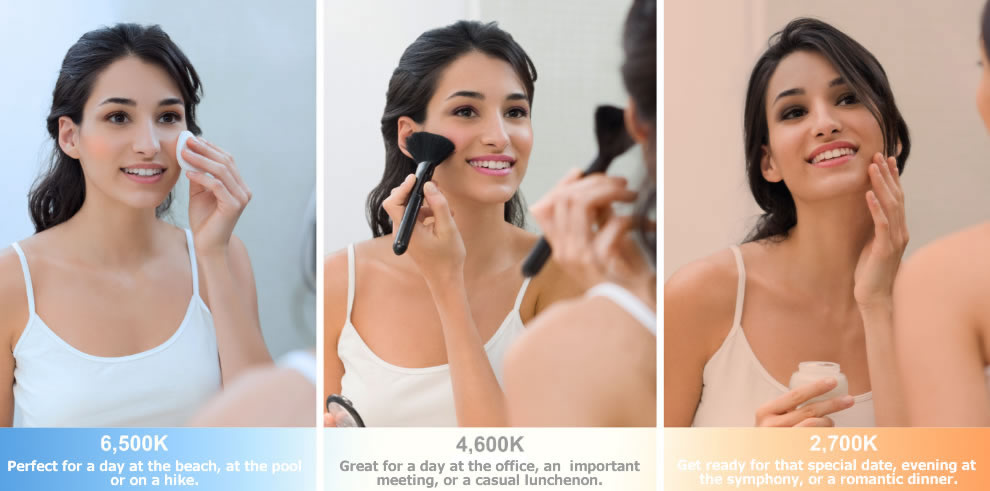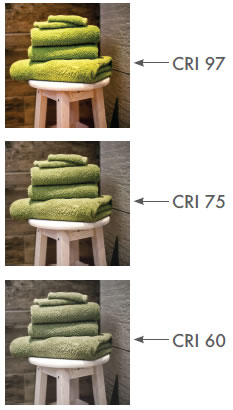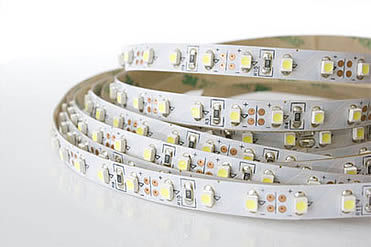Frequently Asked Questions
Everything over $49 ships FREE* - site-wide.
As you look at each product, the lead time is indicated right below the price, as in the two typical examples below.

Hardwired
A hardwired mirror is one that's connected directly to the electrical system. It should be installed by a licensed electrician following all local electrical codes and if in a wet area, wired through a GFI for safety.
Cordless
A cordless makeup mirror is not connected to anything, but it is rechargeable. Recharging is done via a USB port, somewhere on the mirror body, or similarly with an AC adapter.
| Hardwired | Cordless |
|---|---|
| Permanently Connected | Rechargeable by USB or AC Adapter |
| Electrician needed for installation | Just hang where needed |
| Stays with the property | Take it with you if you move |
| Control at the mirror or optionally by wall switch or timer. | On/Off functions at the mirror only |
| Never any visible or exposed wires. | Wire present during recharge every ±2 weeks |
| Mechanical On/Off witching | Switching usually by touch sensor |
Electrician's Hardwired Makeup Mirror Mounting Instructions
• We strongly recommended that installation only be done when the mirror itself is present, and the actual user is available, in order to set the most convenient mounting height.
• Install a 4" octagon box on a GFCI line or on a line where a GFCI outlet is installed, or both. The box should be flush with the mounting surface at a height determined by the user. The box should be capable of supporting 15 lbs. The mirror doesn't weigh 15 lbs., but remember it may be on an arm as long as 20". Note that the center of the mirror is usually 1/2" to 6" higher than the mounting-plate center. All of our hardwired makeup mirrors have the switch contained within the mirror mounting plate, mirror base, or mirror housing. No other switch is required. Also note that each of our single and double arm wall mirrors tilt vertically and swing horizontally.
• Hardwired mirrors, once wired, are no longer eligible for refund.

The color temperature of any light bulb, including LEDs is measured in degrees Kelvin ("k"). The higher the color temperature, the closer the light is to pure white light at 10,000° k. A blue sky sunny day at noon has a color temperature of about 5,500° k. On a very bright cloud-covered day, the sky registers a color temperature of about 6,500° k, while a "regular" incandescent light bulb has a color temperature of about 2,700° k. And most people are most accustomed to that color of lighting in their home.
The color temperature of the lighting in your mirror may affect the way you apply your makeup and thus the way people see you in different situations. It's best, therefore, to choose a lighted makeup mirror with a color temperature to approximate your most frequent environment.
Many of our LED mirrors have their color temperature specified. And some makeup mirrors have adjustable or switchable color temperatures. For those where color temperature is not specified a reasonable guide is this: For incandescent bulbs, a color temperature of around 3,000° k is normal. When no color temperature specification is stated the lighting usually has a color temperatures around 4,000° k. The photos below can serve as a guide.

If you're planning for an outdoor day, the higher the color temperature the better - 5,500° k to 6,500° k.
For office environment lighting conditions, color temperatures around 4,000° to 4,600° k provide the closest match.
For evenings on the town, 2,700°k to 3,500° k is best.
In a word - "Personal Preference" But there's much more infolved that that.
First, it should be noted that there are no standards for mirror magnification specifications. The stated magnification power assigned to a mirror is left completely up to the manufacturer of the mirror. It could be accurate. It could be exaggerated. It could be understated - unlikely. Generally speaking, high quality expensive mirrors have more accurate magnification specifications. In other words it's completely possible for a $25 mirror that claims 10x magnification to magnify less than a $400 mirror with a stated 5x magnification. The difference is that the maker of the $400 mirror is assigning the true magnification value, while the $25 mirror maker exaggerates the magnification in order to sell mirrors to unsuspecting customers.
The is a method that a user can determine the actual magnification power of a mirror requiring only a measuring tape an probably an assistant. On this FAQ page, see "What's the magnification of the mirror I have now."
With all that said, makeup mirrors with 5x magnificaation are by far the most popular, followed closely by 7x. As the magnification power increases, the viewing distance decreases. Thus to see a clear reflection in a 7x mirror, you need to be closer to it than a 5x mirror. There's no getting around this - it's a physical function of optics. In fact, we do have a 15x mirror and the viewing distnace for that mirror is 2 inches! So if you are inclined to order magnifications higher than 7x, be prepared to be pretty close to the mirror, and of course the closer you get, the less of your face is visible. Much of this is explained the the FAQ below, "What's the magnification of the mirror I have now.".
Finding the magnification power of your own Makeup Mirror
Using the measuring tape, follow the steps below:
- 1. Stand far enough from the mirror so that the image you see is upside-down.
- 2. Put the reflection of your eye at the center of the mirror.
- 3. Slowly move closer to the mirror, keeping your eye at the center. It may take a little practice.
- 4. When the image of your eye flips right-side-up and becomes clear, stop.
Only your eye area should be clear, not your entire face. - 5. Measure the distance from your eye to the center of the mirror.
- 6. Find the magnification on the chart below.
| Distance to Eye | Magnification |
|---|---|
| 14" | 3x |
| 12" | 5x |
| 10" | 7x |
| 7.5" | 8x |
| 4.2" | 10x |
| 1.8" | 15x |
It will, however, give you a good approximation of the magnification power of your mirror.

CRI (Color Rendering Index)
In short, the higher the better!
Color rendering index (CRI) is a measure of the ability of a light source to display the colors of various objects faithfully when compared the a natural light source. Light sources with a high CRI value are desirable in color-critical applications such as neonatal care and art restoration. Generally the higher the CRI, the more pleasing to the eye.
The highest possible CRI value is 100 and is frequently achieved by incandescent or "regular" light bulbs. Fluorescent "cool white" bulbs have a CRI of around 50 to 60, but some high-end special use multi-phosphor fluorescents can go up to 98. LEDs typically have an a CRI around 80-85, and better, more expensive LEDs can have CRIs of 90 and higher.
Our LED Bathroom Mirrors and LED Medicine Cabinets have CRIs of at least 90 and most have CRIs even higher.
Magnification = Distortion
What? Yes, by their very nature, magnifying mirrors must be distorted. Almost all magnification-mirrors distort the image. There is an exception - see below*. Otherwise, the trick is to minimize the amount of distortion to an acceptable or even unnoticeable levels.
There are at least two reasons for distortion. The principal reason is that mirrors magnify by using bent glass to form a concave surface which is what creates the magnified reflected image. The greater the degree of magnification, the greater the bend in the glass and the greater the distortion. The center portion of the mirror, at any magnification level, always has the least distortion. In a larger mirror, the absolute size of the center section is relatively larger, and therefore the area of least distortion is larger. This is a significant reason that a larger mirror is preferable.
Another contributing factor is the quality of the mirror glass itself. A poorly made mirror that has irregularities in the curvature of the glass will cause irregularities in magnification causing distortion in the reflected image. For that reason it's best to stick with high quality products.
*An exception to the distortion dilemma: A magnifying mirror made with an actual glass lens fronting a flat mirror can be free from distortion. The mirror must be a high quality mirror and the lens must be of (expensive) optical glass carefully ground to exacting tolerances. Think of it as a creating camera lens that's 7" in diameter. This type of mirror is rare and difficult if not impossible to find. The cost can reach thousands of dollars.
Is that a serious question? Yes. Here's the difference:
Since 1826 or thereabouts when Miroir Brot of France invented the makeup mirror, the term "Vanity Mirror" described a free-standing mirror that stood on a vanity table, a bathroom vanity, or a dresser.
In 2010, or maybe a little earlier, a new type of mirror emerged. Superficially similar to a traditional large flat wall-covering bathroom mirror, this mirror was different. Instead of "just" a plain mirror, the new type had embedded LED lighting strips. Since that time the type and proliferation of these LED bathroom mirrors has increased dramatically. And somewhere along the line these mirrors acquired the name "Vanity Mirror"
Today’s bathroom vanity mirrors have LED lighting that’s front-facing, rear-facing to illuminate the wall and provide ambient lighting, both front and rear lighting, embedded TVs, built-in defoggers, touch sensors, dimmers, and LED color adjustments.
In your bathroom, you can now place a vanity mirror on your bathroom vanity beneath a modern vanity mirror covering the wall.
To maintain clarity we will always refer to a counter-top mirror as "free-Standing", “table-top”, or “counter-top”.
The fog-free function is accomplished via an electrically heated panel backing the mirror glass. There are no plugs or visible wires; everything is done with direct connection to the electric system of the home or builsing and with one exception, the installation is permanent.
Fog-free operation can be found in a number of our product types, including Shower Mirrors, for many if not most of our mirrored Medicine Cabinets, and for quite a number of the wall-covering Bathroom LED Vanity Mirrors. Additionally, some of the Miroir Brot Makeup Mirrors have a small heating element contained within the housing to keep them fog-free.
We do carry one fog-free mirror that runs on a Li-Ion battery rather than house current and that is the Clarity by ClearMirror.
To keep them safe, all of these fogless mirrors operate on low voltagee electricity usually provided by a built-in or wired tranformer. The shower mirrors are permanently installed ("tiled in") in the wall of the shower (with the exception of the Clarity) and are UL and/or ETL listed.
At Perfect Makeup Mirrors, our high-end products generally have LED life expectancies of 30,000, hours, 50,000 hours, and more.
Think of what those numbers translate to:
An LED Mirror in a bathroom might be used let's say 1/2 hour a day. With a 30,000 hour life span, that means after a little more than 164 years, the LEDs will need to be replaced. Ok, let's triple the use - 1-1/2 hours a day. You'll still get about 55 years use. And that's 7 days a week, 365 days a year, including the extra days on leap years! In other words, you needn't think about.
There is a "dark" side to LED lighting, however. Cheaply made LEDs are prone to sudden failure early in their life span. For that reason, it's important to purchase only quality products made by reliable companies that use only quality LEDs.
Replacement
Technically, any LED can be replaced, but as a practical matter this is not always feasible. Here's why: Especially in makeup mirrors where interior space is limited, LED "tapes" are used instead of individual LEDs in replaceable light-bulb-like formats.

LED Tape roll. The tape is about 5/8" wide.
Each 1/4" yellow square is an LED.
In some older makeup mirrors and in larger model mirrors, such as LED wall-sized bathroom mirrors, LED "bulbs" are used. These look like regular light bulbs in sockets and can be replaced. Find replacements on amazon.com, 1000bulbs.com, or other sources.
Flashing LED Lighted Mirrors
This phenomenon is called "strobing". An explanation can be found on this FAQ page under "Why are my makeup mirror lights flashing?"
It's called "Strobing". This is a problem with earlier model LED mirrors - although it can still happen.
If there are touch sensors, a possible cause a static electricity affecting the sensor. Try turning off the power for 30 seconds. If that works, the sensor was probably "stuck" due to static electricity.
More likely, it is the LED driver that's at fault. The LED driver is a small power module held wihin the housing of the mirror that converts the household AC current to the DC voltage needed by the LEDs. Technically, it's possible to replace the LED driver but finding a matching driver is, to say the least, difficult. Neverthelss it can be done, and if you are handy or know someone handy and electrically "savvy", it may be worth attempting to replace the driver, before spending for a new mirror.
Returns
Our general return policy is within 30 days we will send you a return label, no questions asked. We we would ask you to tell us, however, if the product is defective in some way. There are some exceptions to this general statement.
Ineligible for return
1. Mirrors that are custom made such as by Miroir Brot, Electric Mirror, and some others. All custom made mirrors indicate they are custom made, on the ordering page.
2. Hardwired mirrors that have been elecrically connected. Once connected, the mirror is considered used and ineligible for return.
There's one onther thing:
We have one 15x mirror. It's the only product we carry that has a restocking fee. The restocking fee is $25.00
See our complete Refund Policy.
Happy to Help
We are ready to answer your questions from 7 AM to 5 PM Pacific Time, business days.
Use our Contact Form
email: service@PerfectMakeupMirrors.com
Phone: 866-866-5552 press 1 for Customer Service
